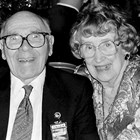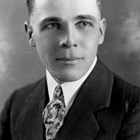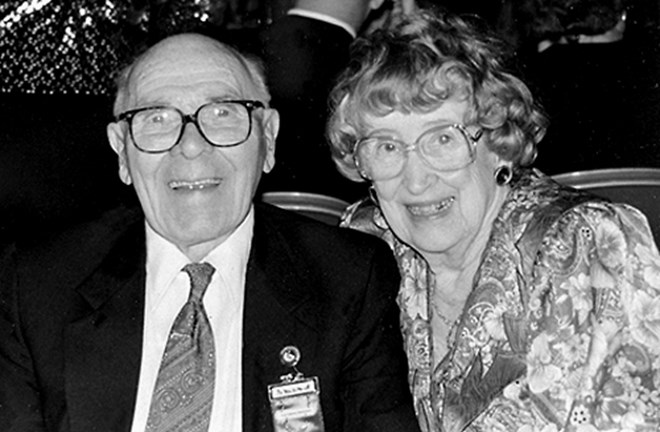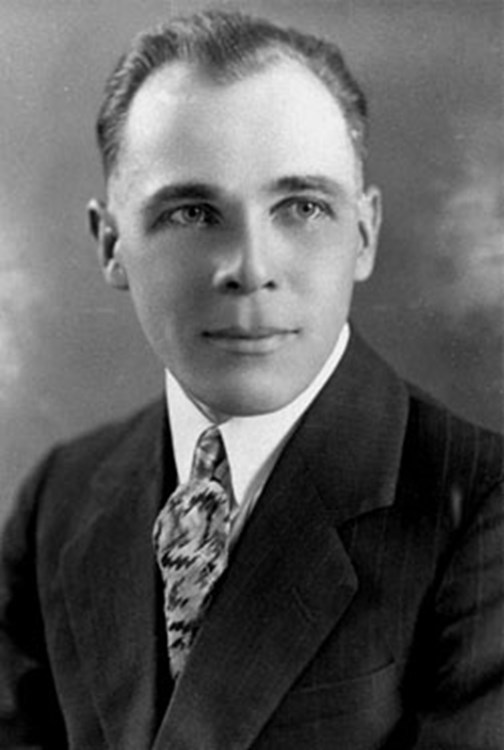Stolt, William A. "Bill"
1900-2001 | Electrical Engineer, Businessman, Civic Leader, and Mayor of Anchorage (1941-1944)
William A. “Bill” Stolt became mayor of Anchorage just before World War II. He served two terms on the Anchorage City Council (1938-1940) and three one-year terms as mayor (1941-1944). In 1933, he and his wife, Lillian “Lily” Stolt, established Stolt’s Electric Supply on Fourth Avenue.
Beginning in 1940, Anchorage benefited from the nation’s massive defense mobilization effort. The military build-up pulled Anchorage out of the depths of the Depression and transformed the city from a railroad town in Cook Inlet into a modern city which became the political, economic, and military center of Alaska. Stolt presided over an incredible expansion of the city as the military built a major base just beyond the town, Fort Richardson. From 1940 to 1950, the population of the city of Anchorage increased by about 600 to 700 percent, from 3,495 to 11,254. Determined, hardworking, and well-liked, Stolt worked diligently to help Anchorage meet the challenges caused by sudden rapid population growth.1
Finnish Immigrant Roots
William Alex “Bill” Stolt was born on July 5, 1900, in Boston, Massachusetts, to Alex Wilhelm Stolt and Eliina Pukkila Stolt. He was christened Alex William Stolt, but in his early school days, he interchanged the two names and used the name William Alex Stolt for the rest of his life.2
His father, Alex Wilhelm Stolt, and mother, Eliina Pukkila Stolt, were married in 1897 in Tampere, Finland, shortly before they came to America. His father, Alex Stolt, a draftsman studying to become an engineer and to obtain an engineering degree in Finland, had to gain experience by working two years in either Germany or America. His father became ill not long after his birth and the family returned to Finland, where he died six months later. Bill spent the next ten years of his life in Finland. Bill’s mother worked as a skilled weaver in a Finnish textile mill to support the family until she lost her position after all workers in the woolen and cotton mills went on strike. The strike caused his mother to be blacklisted and barred from any work in the textile industry. She relocated to the United States to find work when he was four. Bill was sent to live with his grandparents, traveling by himself by train from Tampere to Vilppula.3
When Stolt was ten, his mother, Eliina Pukkila Stolt, married a Finnish immigrant, Charles Kusisto, in Waukegan, Illinois. When Kusisto’s first wife died a few years earlier, he sent his only child, a daughter named Fanny, to be cared for by relatives. In 1910, when Bill was ten and then unable to speak English, he was accompanied by his stepsister, Fanny, age sixteen, to join his mother and stepfather in Seattle. After having a year of elementary school in Finland, Bill entered the second grade at Interbay Public School and, as his English improved, advanced to the fourth and fifth grades. In Seattle, his stepfather worked construction jobs in neighboring cities and was absent except for occasional weekends. His mother worked in a downtown Seattle laundry.4
In 1913, the family moved to Juneau, where Stolt’s stepfather, Charles Kusisto, worked on a construction job on the Goldstein Building. Stolt became a paper boy for the Juneau Daily Empire, earning $7.50 a month. His brother, Paul, was born on March 31, 1915, while the family lived in Juneau.
In 1917, the family moved to Anchorage, where his stepfather had moved the previous year to find work with the Alaskan Engineering Commission (AEC), the temporary federal agency in charge of construction of the Alaska Railroad. When Stolt arrived in Anchorage as a teenager, he was not impressed. When he was ninety-five, Stolt recalled for a reporter: “Anchorage looked pretty desolate and dismal to me. I thought to myself, ‘When I get through school and get enough money, I’ll be getting out of here.’ ”5 The family lived in a small house that his stepfather had built, located about four blocks east of C Street and Fourth Avenue.6
Throughout high school, Stolt worked a number of jobs to help support the family. After school, he repaired old office equipment at an office supply store, helping to fill repair orders for the AEC. In 1918, he worked as an office boy and messenger for the AEC. In the summer of 1919, he was hired to assist in survey work on the Alaska Railroad construction project. In 1920, he was valedictorian of his high school class, which consisted of him and another boy.
Stolt entered Washington State College in the fall of 1920. To fund his education, he took time away from school to work on bridge gangs, doing office work, or other jobs for the AEC in Anchorage. He eventually earned a Bachelor of Science degree in electrical engineering in 1926. He began his professional career with the Alaska Railroad and worked three and a half years in the electrical department before leaving to gain additional experience by working for one of the larger electrical companies on the west coast.7
Lillian “Lily” Rivers Stolt (1907-2005)
In December of 1929, Stolt married Lillian “Lily” M. Rivers, a high school student whom he met in 1923 on the dance floor at the old Pioneers Hall at Sixth and F Street. The Stolts had three children – William in 1932, Wayne in 1936, and Elaine in 1940.
Lily Rivers was born on February 11, 1907, in Superior, Wisconsin, to Finnish parents, Carl and Helma Rivers. She grew up in northern Minnesota, Oregon, and Washington. In 1920, the family moved to Anchorage, where her father was hired to be an air brake maintenance man by the AEC on the Alaska Railroad. Lily graduated from Anchorage High School, Class of 1924, which had a total of three graduates. In the summer of 1923, Lily worked in the AEC's Disbursing Office before leaving for Washington State College, where she had a scholarship.8 Lily attended Washington State College for two years and received a B.A. degree in Economic Science in 1926. She returned to Anchorage and resumed working for the Alaska Railroad (a separate federal agency under the U.S. Department of the Interior) until their marriage.
After Bill and Lily married in 1929, they lived in Oakland, Los Angeles, and Seattle for a few years. In Seattle, Bill worked for two years in the electrical department of General Electric Company.
Life in Alaska
In the spring of 1932, the Stolt family returned to Alaska when he was offered an opportunity to work for the Gold Top Syndicate, a Canadian firm, developing a new mining prospect in the Willow Creek mining district north of Anchorage. He maintained and made repairs on the site’s power plant until the mine shut down the following April.9 He worked several small jobs, at Alaska Light and Power Company’s Eklutna hydroelectric plant, and for Emard's Packing Company, the largest of the Anchorage canneries located along the mouth of Ship Creek.
In 1933, Bill and Lily opened Bill’s Electric, later called Stolt’s Electric Supply, which they operated for thirty years. Lily refurbished a downtown building on Fourth Avenue that once housed Sydney Laurence’s photography studio into both a business and living quarters while Stolt worked for the Emard cannery. Bill did the outside contracting while Lily handled all of the bookkeeping and office work. Much of Stolt’s work came from the coal and gold mines which were very active in the region. The Stolts slowly began to build up a retail business based on appliances, and as their business grew added staff. As the years passed, the Stolts also branched into refrigeration and built up a shop to repair electric motors.10
Bill and Lily enjoyed recreational activities in the Anchorage area, and often visited Otter Lake, outside Anchorage, for recreation. Bill had hunted, fished and trapped in the area while still in school, and knew the area well. In 1938, they applied for a homestead on 122.22 acres on the lower half of Otter Lake and had a snug cabin built. In May 1942, they relinquished their land to the federal government, as their homestead was within a twelve square-mile area north and east of Anchorage set aside for military purposes, and construction of Fort Richardson. In 1943, the Stolts received $1,500 from the government for the value of the cabin.11
Anchorage City Council (1938-1940)
As Stolt worked in Anchorage he became concerned that the city was not extending and improving its power grid to residents living on the outskirts of town, who were eager to obtain electrical service. He decided the solution was to become a member of the city council and cause the grid to be expanded.12 In April 1938, he was elected for a two-year term and received by far the greatest number of votes for any council candidate.13 On May 4, 1938, the city council unanimously approved Stolt’s motion to commit $5,000, a large sum at that point, to purchase copper wire to increase and improve the city’s electrical grid. This was the beginning of a modern electrical system for the city, and when the military construction boom period started in 1940, the city was able to handle the load.14
Mayor of Anchorage (1941-1944)
In 1940 Stolt ran unsuccessfully for mayor, losing to George Vaara. In April 1941, Stolt ran for mayor again and won. Three days before the election, Mayor George Vaara withdrew from the race, sending a radiogram from Seattle stating that he was no longer a candidate for re-election. Stolt swamped lawyer Clyde Ellis, the president of the Anchorage Chamber of Commerce, defeating him by 148 votes as he totaled 569 to Ellis’s 421.15
Stolt was up for re-election in 1942, and faced Keith Capper, a write-in candidate. Capper was a former police officer and the operator of the Lido Gardens. In the April 7 election, Stolt polled 531 votes and his opponent, Capper, polled 310.16
In his third successive win in a mayoral race in April 1943, Stolt was re-elected by better than a two to one majority over Keith Capper. The official vote count was 682 for Stolt and 276 for his opponent.17
During Stolt’s three terms as mayor (1941-1944), the most significant action taken was to pass Ordinance No. 139, which called for a special election on the question of whether the city should purchase the Anchorage Light and Power Company. AL & P was the private company that supplied the city with electricity from a hydroelectric plant on the Eklutna River, about forty miles northeast of Anchorage. Largely through the personal efforts of Mayor Stolt, the voters approved $1,250,000 in general obligation bonds. Of the 510 votes cast in the special election of August 17, 1943, there were 328 votes “for” and 177 “against.” Although the city had to bond itself for over a million dollars, owning the utility saved city taxpayers substantial sums in subsequent years.18 The small power plant served Anchorage from 1929 until 1956, a time when the town grew from a small railroad town to the largest of Alaska’s cities. The city owned the power plant from 1943 to 1956, when it was purchased by the U.S. Bureau of Reclamation. By 1956, the old plant had exceeded its capacity and could no longer meet the growing electrical demands of the city. It was replaced by a much larger hydroelectric plant at Eklutna by the U.S. Bureau of Reclamation.19
The years 1940 and 1941 marked a watershed in Anchorage history, when the town suddenly began to explode because of the job opportunities offered by military construction as the military built Fort Richardson and other bases around Alaska.20 The Alaska Railroad set new military and civilian traffic records, but fell to pieces under the pounding of the U.S. Army’s enormous tonnages.21 At the peak of construction of Fort Richardson in August 1941, a total of 3,415 civilian workers were employed to build the largest and most expensive military base built in Alaska during World War II. The number of construction workers was only slightly less than the entire pre-war population of Anchorage. By 1942, Fort Richardson had a garrison for more than 15,000 soldiers, and throughout World War II, the base was the main staging area and support base for the U.S. Army’s posts on the Aleutian Chain.22
As early as 1942, the Anchorage City Council sought to cope with this situation by preparing a five-year public works program with the assistance of the National Resources Planning Board. The plan called for extensive public works, including a new airport, improvements and extension of the water and sewage systems, street improvements, expansion of the telephone system, a health center, a high school and gymnasium, and a community center. Some of these projects got underway during the war, but most had to wait until the postwar period.23
There was a major housing shortage and increased demands for all services. Fear of a Japanese invasion of southcentral Alaska after the bombing of Pearl Harbor on December 7, 1941 brought nightly blackouts for all residents. The military urged women and children to move to the Lower forty-eight states because of fears that Japanese submarine attacks could halt food shipments. Lily Stolt, to set an example for the rest of the community, took the family’s two younger children to St. Paul, Minnesota. Territorial Guard units were organized. Japanese-born residents of Anchorage, such as the Kimura family, which had settled in Anchorage in 1915, were moved to internment camps in the western United States.24 The city council voted on May 5, 1943 to spend $3,000 improving the jail in the new city hall, because of the increased demand on the facility. The problem of drunken soldiers “rampaging down Fourth Avenue” was solved when General Simon Bolivar Buckner shipped them to the Aleutians as punishment. Years later Stolt remembered that after that, “My God, they behaved themselves.”25
While supporting the war effort, Anchorage, as represented by Stolt and the city council, strongly opposed the military’s attempt to build barracks on the city golf course. As Bob Atwood of the Anchorage Daily Times noted in an April 17, 1943 editorial, building barracks on the golf course “makes a military target of the city of Anchorage.” The barracks were built elsewhere.26
As mayor, Stolt dealt with trying to improve the town’s infrastructure while attending to the endless everyday details of street, sewer, and property assessment complaints or persuading a number of civic organizations to agree on establishing a permanent caretaker for the local cemetery. At the beginning of his third term in 1943, Stolt and the city council were still attempting to push forward a “gravity” water system to improve the city’s water supply.
Some of the problems caused by the rapid expansion of the city were detailed on a report written on Anchorage by Ralph Browne for the Alaska Development Board, entitled Alaska’s Largest City (1952).27 Anchorage emerged from World War II with inadequate civic facilities and a critical shortage of housing. It had immediate needs for more schools, playgrounds, and roads, improved fire and police protection, increased capacity for sewer and garbage disposal, a larger water supply, and expanded facilities for the production of electricity.28
Life after Local Politics
Stolt stepped down as mayor in April 1944 and devoted his time to his family and business. In 1951, Stolt was appointed the Honorary Consul of Finland for Alaska, serving for thirty-two years. He was awarded the Insignia of Commander in the Order of the Red Lion of Finnish Knighthood, the highest decoration that could be given by Finland to a foreign citizen.
In 1951, Bill and Lily began building a home close to Cook Inlet on the west side of town near Bootlegger Cove. Their street was officially named Stolt Way. They moved into their new home as Mount Spurr was erupting across Cook Inlet in 1953. In 1957, Bill and Lily joined and became active members of the Pioneers of Alaska. Bill became president of the Anchorage Chapter, Igloo 15, during the 1960s, and became Grand President of the statewide organization in 1967. Lily became president of the women’s Auxiliary Number 4 in 1970. Bill and Lily were crowned Fur Rendezvous Regents in 1965.
In 1961, Bill and Lily turned their electrical business over to their son Wayne, and Bill retired. Lily concentrated her efforts on a new business, the Stolt Gift Center, which sold a variety of goods, including Native arts and crafts. The 1964 Alaska earthquake caused considerable damage to the gift shop’s inventory, but the Stolts continued their involvement with the shop until 1979.29
Final Years
The Stolts remained active in Anchorage for many years. Bill was a member of the Elks, Rotary Club, and the Anchorage Chamber of Commerce.30 He and Lily were members of the Anchorage Finland-Suomi Club. In 1997, they published their autobiography, Bill and Lily, Two Alaskans, a collection of stories based on their lifetime experiences. In 1998, they were named Laureates of the Alaska Business Hall of Fame.31 In 2000, they jointly received the Denali Award for Alaskan of the Year.
William Alex “Bill” Stolt died on February 28, 2001 at the Pioneer Home in Anchorage at the age of one hundred. Lillian “Lily” Margaret Stolt lived to 2005, when she died at ninety-eight years of age.32 The couple is interred at the Anchorage Memorial Park Cemetery in downtown Anchorage.
Endnotes
1. See Terrence Cole, “Boom Town: Anchorage and the Second World War,” in The Pacific Northwest in World War II, ed. Carlos A Schwantes, 75-85 (Manhattan, KS: Sunflower University Press, 1986); and Stephen Haycox, “Mining the Federal Government: The War and the All-America City,” in Alaska at War, 1941-1945: The Forgotten War Remembered, ed. Fern Chandonnet (Anchorage: Alaska at War Committee, 1995; reprint edition, Fairbanks: University of Alaska Press, 2008), 203-209.
2. William and Lilian Stolt, Bill and Lily, Two Alaskans (Anchorage: Publications Consultants, 1997), 243. This informal autobiography, written in alternating sections by Bill and Lily Stolt, provided most of the details about their lives and their experiences over an eight-decade period.
3. Ibid., 9-10.
4. Ibid., 15-17.
5. Liz Ruskin, “Ex-mayor Bill Stolt dies at 100 – Pioneer: Man watched Anchorage grow from town to city,” Anchorage Daily News, March 1, 2001, B-1.
6. William and Lilian Stolt, Bill and Lily, Two Alaskans, 18-20.
7. Ibid., 30-33.
8. William and Lilian Stolt, Bill and Lily, Two Alaskans, 41-46; Kristy Hollinger, Homesteads on Fort Richardson, Alaska, edited by Glenda R. Lesondak (Fort Collins, CO: Center for Ecological Management of Military Lands, Colorado State University and Fort Richardson, AK: Natural Resources Branch, U.S. Army, 2001): 41); and Fond Memories of Anchorage Pioneers, Volume 1 (Anchorage: Pioneers of Alaska, Igloo 15, Auxiliary 4, 1996), 225.
9. William and Lilian Stolt, Bill and Lily, Two Alaskans, 91-100.
10. Ibid., 79-82.
11. Kristy Hollinger, Homesteads on Fort Richardson, Alaska: 42; and William and Lilian Stolt, Bill and Lily, Two Alaskans, 133-135.
12. William and Lilian Stolt, Bill and Lily, Two Alaskans, 80.
13. Minutes, April 6, 1938, Anchorage City Council Minutes, Volumes III-IV, June 7, 1933-April 16, 1941 (microfilm edition), Alaska Collection, Z.J. Loussac Library, Anchorage Public Library, Anchorage, AK.
14. Minutes, May 4, 1938, Anchorage City Council Minutes.
15. “Stolt Named Mayor over Ellis; Gymnasium Carries,” Anchorage Daily Times, April 2, 1941, 1.
16. “Steady Voting Stream Marks City Election,” Anchorage Daily Times, April 7, 1942, 1; and “City Council to have First Woman Member, 907 Cast Ballots,” Anchorage Daily Times, April 8, 1942, 1.
17. “Stolt, Bevers, Wadman and Andreson are in,”Anchorage Daily Times, April 7, 1943, 1.
18. Minutes, June 7 and 9, and August 8, 1943, Anchorage City Council Minutes, Volumes V-VI, May 7, 1941-June 4, 1948.
19. Kristy Hollinger, The Early Electrification of Anchorage, edited by Glenda R. Lesondak (Fort Richardson, AK: Natural Resources Branch, U.S. Army Alaska; Fort Collins, CO: Center for Environmental Management of Military Lands, 2002): 43-44;Terrance Cole and Elmer E. Rasmuson, Banking on Alaska: The Story of the National Bank of Alaska, Volume 1: A History of NBA (Anchorage: National Bank of Alaska, 2000), 158-162; and Michael Carberry and Donna Lane, Patterns of the Past: An Inventory of Anchorage’s Historic Resources (Anchorage: Community Planning Department, Municipality of Anchorage, 1986): 123.
20. Claus-M. Naske and L.J. Rowinski, Anchorage: A Pictorial History (Norfolk, VA: Donning Company, Publishers, 1981), 126.
21. William H. Wilson, Railroad in the Clouds: The Alaska Railroad in the Age of Steam, 1914-1945 (Boulder, CO: Pruett Publishing Company, 1977), 258-261.
22. Terrence Cole, “Boom Town: Anchorage and the Second World War,” in The Pacific Northwest in World War II, 79.
23. Claus-M. Naske and L.J. Rowinski, Anchorage: A Pictorial History, 127.
24. Preston Jones, City for Empire: An Anchorage History, 1914-1941 (Fairbanks: University of Alaska Press, 2010), 127-136 and 157-158.
25. “Pioneer Mayor,” Anchorage Daily News, July 9, 1995, E-1 and E-3.
26. “The Problem of the Golf Course,” Anchorage Daily Times, April 17, 1943, 2.
27. See Ralph Browne, Alaska’s Largest City, Anchorage, an Analysis of its Growth and Future Possibilities, 1951-1952 (Juneau: Alaska Development Board, 1953).
28. Terrence Cole, “Boom Town: Anchorage and the Second World War,” 84.
29. “Alaska Loses Pioneer Wife of Former Mayor, Councilman – Obituary,” Anchorage Daily News, August 31, 2005, B-9.
30. Entry for William A. Stolt, in Edmund C. Jeffery, editor, Alaska: Who’s Here, What’s Doing, Who’s Doing It, 1955 (Anchorage: Jeffery Publishing Company, 1955), 186.
31. “4 to be Inducted into State Business Hall of Fame,” Anchorage Daily News, January 27, 1998, F-1.
32. “Alaska Loses Pioneer Wife of Former Mayor, Councilman – Obituary,” Anchorage Daily News, August 31, 2005, B-9.
Sources
This biographical sketch of William A. Stolt is based on an essay originally published in John P. Bagoy’s Legends & Legacies, Anchorage, 1910-1935 (Anchorage: Publications Consultants, 2001), 160-161. See also the Fred Howe file, Bagoy Family Pioneer Files (2004.11), Box 4, Atwood Resource Center, Anchorage Museum at Rasmuson Center, Anchorage, AK. Edited by Mina Jacobs, 2012. Note: edited, revised, and expanded by Walter Van Horn and Bruce Parham, October 15, 2015.
Preferred citation: Walter Van Horn and Bruce Parham, “Stolt, William A. ‘Bill’,” Cook Inlet Historical Society, Legends & Legacies, Anchorage, 1910-1940, http://www.alaskahistory.org.
Major support for Legends & Legacies, Anchorage, 1910-1940, provided by: Anchorage Museum at Rasmuson Center, Atwood Foundation, Cook Inlet Historical Society, and the Rasmuson Foundation. This educational resource is provided by the Cook Inlet Historical Society, a 501 (c) (3) tax-exempt association. Contact us at the Cook Inlet Historical Society, by mail at Cook Inlet Historical Society, Anchorage Museum at Rasmuson Center, 625 C Street, Anchorage, AK 99501 or through the Cook Inlet Historical Society website, www.cookinlethistory.org.



